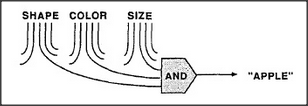# 19.6 RECOGNIZERS
When we see an apple, how do we know it as an apple? How do we recognize a friend — or even know when we're seeing a person? How do we recognize things? The simplest way to recognize something is to verify that it has certain properties. To recognize an apple, in many circumstances, it might suffice to look for something that is red AND round AND apple-sized. In order to do that, we need a kind of agent that detects when all three conditions occur at once. The simplest form of this would be an agent that becomes active whenever all three of its inputs are active.

This scheme, too, will make mistakes. It will miss the chair if too many features are out of sight. It will mistake other objects for chairs if those features are present but in the wrong arrangement — for example, if all four legs are attached to the same side of a "seat." Indeed, it usually won't suffice merely to verify that all the required parts are there — one also has to verify their dimensions and relationships; otherwise our recognizer would not distinguish a chair from a couch or even from a bunch of boards and sticks. Failure to verify relationships is the basis of a certain type of nonsense joke:
What has eight legs and flies? --- A string quartet on a foreign tour.